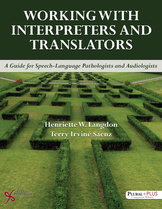Publication
Working with Interpreters and Translators
A Guide for Speech-Language Pathologists and Audiologists
- Edited by: Henriette W. Langdon, Terry Irvine Saenz
- Details:
- 267 pages, Illustrated (B/W), Softcover, 7 x 10" 1 lbs
- Included Media:
- Companion Website
- ISBN13:
- 978-1-59756-611-7
- Release Date:
- 10/15/2015
Overview
Working with Interpreters and Translators: A Guide for Speech-Language Pathologists and Audiologists offers state-of-the-art procedures to conduct interviews, assessments, and conferences with students with limited English language proficiency and their families. As no research base is available in the field of communicative disorders on this specific topic, the information presented in this guide is supported by a critical review of the literature on best practices in interpreting for international conferences and legal and medical fields. Furthermore, the authors' experience working with language interpreters and training professionals as well as graduate students in communicative disorders, makes this a very valuable resource for professionals, interpreters/translators, as well as undergraduate and graduate students.
Federal and state laws specify that, if necessary, English-language learners (ELL) need to be assessed in their native language when referred for possible special education. The number of ELL students attending public schools across the nation has increased in the past few decades. There are not enough speech-language pathologists (SLPs) or audiologists who are proficient in the various languages spoken by ELL students--even in Spanish, the most common language spoken by ELL students in the United States. The next best solution is to conduct assessments in collaboration with a trained interpreter/translator.
Key features include:
- Information and references for the most common languages spoken by ELL students
- Discussion of culturally based variables that need to be considered in the process of interviewing and working with linguistically and culturally diverse populations
- Description of the roles and responsibilities for individuals who will be collaborating as interpreters and translators with SLPs and audiologists in various contexts, such as interviews, assessments, and various meetings (such as IEPs and IFSPs), as well as suggestions on training individuals in this collaborative process
- Review of best practices in speech-language and audiological assessments, both with and without materials in the given language
- Five video clips that illustrate various facets of the interpretation and translation process included on a PluralPlus companion website
Working with Interpreters and Translators: A Guide for Speech-Language Pathologists and Audiologists is a must-have reference for anyone working with ELL students. Although the process was developed with the pediatric population in mind, much of this information can be applied to older culturally and linguistically diverse populations in need of speech-language and/or hearing services. It will also be useful to professionals working with language interpreters in allied health professions in other countries.
Sample video from the companion website:
Review
Doody's (May 2018):
"Named to Doody's Core Titles in the Health Sciences - Speech, Language & Hearing 2018 list."
Part I. A Guide for the Speech-Language Pathologist and Audiologist
Chapter 1. Bridging Linguistic Diversity
- Henriette W. Langdon
Chapter 2. Communication Issues in a Multilingual Society
- Henriette W. Langdon
Chapter 3. Cultural Elements
- Terry Irvine Saenz
Chapter 4. Interpreting and Translating in Speech-Language Pathology and Audiology
- Terry Irvine Saenz
Chapter 5. Three Important Steps: Briefing, Interaction, and Debriefing (BID Process)
- Henriette W. Langdon
Chapter 6. Assessing Bilingual/Culturally and Linguistically Diverse Children
- Henriette W. Langdon
Chapter 7. Enhancing Professional Development Programs and the Future of Interpreters
- Teresa L. Wolf
Part II. A Guide for the Interpreter/Translator
Chapter 8. The Interpreting and Translating Process
- Henriette W. Langdon
Chapter 9. The Interpreter/SLP or Audiologist Collaboration Process
- Henriette W. Langdon
Chapter 10. Evaluation and Outcome of the Process
- Henriette W. Langdon
About The Editors
Henriette W. Langdon, EdD, FASHA, CCC-SLP, is an ASHA-certified speech-language pathologist, ASHA Fellow, and professor of communicative disorders and sciences at San José State University in San Jose, California. She has forty years of experience working with bilingual students who have a variety of speech, language, communication, and learning challenges, and she has lectured and presented workshops locally, nationally, and internationally on this topic using English, Spanish, and/or Polish.
Terry Irvine Saenz, PhD, CCC-SLP, is a professor of communicative disorders at California State University, Fullerton. She is the author of several journal articles on bilingual/multicultural speech-language pathology and coeditor with Dr. Henriette W. Langdon on Language Assessment and Intervention with Multicultural Students: A Guide for Speech-Language-Hearing Professionals. Dr. Irvine Saenz is the 2015 recipient of the California Speech-Language-Hearing Association's Diversity Award.
Related Titles
Culturally Responsive Practices in Speech, Language, and Hearing Sciences
Yvette D. Hyter, Marlene B. Salas-Provance
366 pages, Illustrated (B/W), Softcover, 7 x 10"
Science of Successful Supervision and Mentorship
331 pages, Illustrated (B/W), Softcover, 6 x 9"
Workplace Skills and Professional Issues in Speech-Language Pathology
392 pages, Illustrated (B/W), Softcover, 6 x 9"
Working with Families in Speech-Language Pathology
Nicole Watts Pappas, Sharynne McLeod
358 pages, Illustrated (B/W), Softcover, 6 x 9"
Professional Communication in Audiology
Virginia Ramachandran, Brad A. Stach
160 pages, Illustrated (B/W), Softcover, 6 x 9"
Telepractice in Speech-Language Pathology
392 pages, Illustrated (B/W), Softcover, 6 x 9"
Supporting Family Caregivers of Adults With Communication Disorders
304 pages, Illustrated (B/W), Softcover, 6 x 9"
Patient-Provider Communication
Edited by: Sarah W. Blackstone, David R. Beukelman, Kathryn M. Yorkston
352 pages, Illustrated (B/W), Softcover, 7 x 10"
Narrative-Based Practice in Speech-Language Pathology
368 pages, Illustrated (B/W), Softcover, 6 x 9"
Purchasers of this book receive complimentary access to supplementary videos hosted on a PluralPlus companion website.
Materials:
- Video clips
To access the videos, log in to the website using the URL and Access Code located inside the front cover of your copy of Working with Interpreters and Translators: A Guide for Speech-Language Pathologists and Audiologists.


















